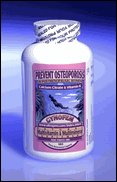Osteoporosis: The Top Tactics to Prevent Low Bone Mass
& Osteoporosis
by www.SixWise.com
Osteoporosis, a disease that leads to frail bones and an increased susceptibility
to fractures, is a major U.S. public health threat on its way to reaching epidemic
proportions on par with obesity and diabetes. Already, 10 million Americans have
osteoporosis, but another 34 million have low bone mass, which puts them at an increased
risk of developing the disease, according to the National Osteoporosis Foundation
(NOF).
|

Eating a healthy diet, including plenty of green leafy vegetables, is one of the
best ways to build bone health and prevent osteoporosis.
|
Although the disease can affect men, 80 percent of those inflicted are women. That
means that of the 10 million people who have osteoporosis in the United States,
8 million are women and 2 million are men. This "silent killer" causes
bone loss with no symptoms, and often people don't know they have it until their
bones are extremely weak and prone to fractures.
Why is Osteoporosis Increasing?
Osteoporosis often manifests in those over the age of 50 (although it can strike
any age), and as the Baby Boomer generation continues to age, more and more of us
are passing this threshold. For women, this age is so monumental because up to 20
percent of bone mass can be lost in the five to seven years following menopause,
which increases the risk of osteoporosis substantially, says the NOF.
|
Major Risk Factors for Osteoporosis

According to the National Osteoporosis Foundation, the following risk factors could
increase your risk of osteoporosis:
-
Personal history of fracture after age 50
-
Current low bone mass
-
History of fracture in a 1° relative
-
Being female
-
Being thin and/or having a small frame
-
Advanced age
-
A family history of osteoporosis
-
Estrogen deficiency as a result of menopause, especially early or surgically induced
-
Abnormal absence of menstrual periods (amenorrhea)
-
Anorexia nervosa
-
Low lifetime calcium intake
-
Vitamin D deficiency
-
Use of certain medications, such as corticosteroids and anticonvulsants
-
Presence of certain chronic medical conditions
-
Low testosterone levels in men
-
An inactive lifestyle
-
Current cigarette smoking
-
Excessive use of alcohol
-
Being Caucasian or Asian, although African Americans and Hispanic Americans are
at significant risk as well
|
But, surprisingly, the most crucial ages for bone health are not the "golden
years" -- by the time a woman has reached the age of 20, she's already acquired
about 98 percent of her skeletal mass. So, the best time to build your bones, and
set up your defense against this potentially debilitating disease later, is actually
during childhood and adolescence.
"We (generally) build bone up until 20 to 25 years of age and start losing
mass at about age 35 ... But doctors are currently finding low bone mass in children
as young as 14 years old," said Kim Clark, RN, BSN.
The increasing incidences of low bone mass, and in younger and younger ages, may
be due to the less-than-optimal standard American diet, including its lack of calcium,
which is necessary for healthy bones.
"By 2020, half of all Americans over the age of 50 will have osteoporosis,
if we don't change our dietary patterns," said Clark. "Americans are predominantly
living on dense calories without dense nutrients, like sugars, refined carbohydrates
and fried foods--all with a lack of calcium ... And pop has phosphorus
in it, which, in large amounts, leaches calcium from the body."
Who's Most at Risk, and How can Osteoporosis be Prevented?
Along with age, there are many other factors that can increase a person's risk of
osteoporosis. Take a look at the list to the right for a complete list, but some
of the major ones include a family history of the disease, having a small body frame
and being thin, being female, not getting enough calcium, magnesium, boron, zinc,
folic acid, or vitamin D in your diet, inactivity,
excessive drinking and cigarette smoking.
Further, according to Clark, "Bulimia or anorexia, kidney disease, use of thyroid
medicine or Dilantin, chronic use of
antacids that contain aluminum and malabsorption syndromes including chronic
diarrhea, Crohn's disease and surgical removal of the stomach and/or intestines
may contribute to development of osteoporosis."
However, no matter how many risk factors you may have (or not have), there are steps
you can take to strengthen your bones and decrease your risk of osteoporosis, no
matter what your age. These include:
1. Eating a healthy diet rich in vitamins and minerals like calcium and vitamin D.
This includes fruits, vegetables (green leafy vegetables and broccoli are great
sources of calcium!), dairy products and more. (Vitamin D can also be obtained through
sensible sun exposure.) Remember that a healthy diet is important for kids' bone
health too! If you're concerned that your diet isn't providing you with enough of
the minerals your body needs, you may want to try
Gynofem Osteoporosis Formula, an all natural multi-mineral and vitamin supplement
that has been shown to have a significant impact in preventing and reversing post-menopausal
bone loss, and has the added benefit of long-lasting effects in the increase of
bone density.
|
GynoFem Osteoporosis Formula for Optimal Bone Health
 GynoFem
is an all natural multi-mineral and vitamin supplement, specifically formulated
to prevent osteoporosis. Why GynoFem? GynoFem
is an all natural multi-mineral and vitamin supplement, specifically formulated
to prevent osteoporosis. Why GynoFem?
-
It is the only supplement combining calcium citrate and magnesium oxide with vitamin
D for absorption and vitamin K for proper bone alignment.
-
This special formula provides 1200 mg of calcium citrate and 600 mg of magnesium,
the highest recommended dosage, in the correct form, of calcium and magnesium, as
recommended by the National Institute of Health, the world's foremost authority
on osteoporosis.
-
Gynofem contains no animal products, sugars, starch, corn antigens, dairy products,
wheat products, yeast products, fish oil, kelp, artificial colors, artificial flavors
or preservatives.
Learn More About GynoFem Osteoporosis Formula's Benefits to Your Bone Health, and
Order Now!
|
2. Getting plenty of weight-bearing exercise. These exercises (jogging, walking,
yoga, kick boxing, weight lifting, etc.) can help build bone mass.
3. Not smoking or drinking excessively. People who drink more than two alcoholic
beverages a day and those who smoke currently may increase their risk of this disease.
4. Talking with your physician about bone density testing. Your doctor can
help you determine whether a bone mass measurement (also called bone mineral density
or BMD test) is necessary. The test measures your bone density so you know if it's
within the normal range for your age or if you're at risk of a fracture. You and
your doctor can then determine the best course of action to take to protect your
bone health.
Recommended Reading
The Real Facts
on Natural Progesterone: What Women Need to Know
The Six Debt
Triggers for Women
Sources
Kansas City Nursing News May 23, 2005
National Osteoporosis Foundation